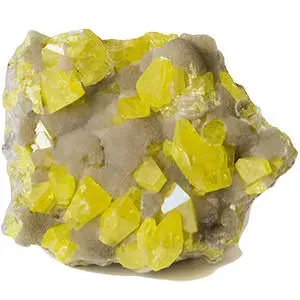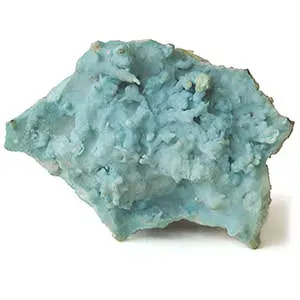 Aragonite was named in 1790 after the Spanish province of Aragon, where it was first noted. Aragonite is a carbonite mineral, chemically the same as calcite, but with a fibrous, rounded form and no rhombohedral cleavage. It is a popular glassy ornamental stone that can be found in layered or banded varieties. The shells of certain mollusks, such as abalone, are actually made of aragonite, which gives them a mother-of-pearl luster. Many fossil shells now composed of calcite were originally formed of aragonite, which is unstable in high pressures and temperatures. These fossils have usually lost their original pearly luster. Natural pearls are also mostly formed by aragonite which bonds with conchiolin, a process that takes 7 years to complete.
Aragonite was named in 1790 after the Spanish province of Aragon, where it was first noted. Aragonite is a carbonite mineral, chemically the same as calcite, but with a fibrous, rounded form and no rhombohedral cleavage. It is a popular glassy ornamental stone that can be found in layered or banded varieties. The shells of certain mollusks, such as abalone, are actually made of aragonite, which gives them a mother-of-pearl luster. Many fossil shells now composed of calcite were originally formed of aragonite, which is unstable in high pressures and temperatures. These fossils have usually lost their original pearly luster. Natural pearls are also mostly formed by aragonite which bonds with conchiolin, a process that takes 7 years to complete.
 Aragonite is usually transparent or translucent and vitreous. It is colorless or white when pure. When not pure, aragonite can be of various shades of yellow, blue, pink or green. Aragonite is a fairly brittle stone, rating a 3.5 on the hardness scale so it is not usually faceted for jewelry. The stone also has poor cleavage. Aragonite crystals often are prismatic and if three twins occur, the mineral becomes pseudo hexagonal. This form of aragonite is called "flos-ferri," or "iron flowers," as it has thin, intertwined and clumping branches that resemble worms or trees. These specimens are usually found around Austria, Russia, Mexico, and the United States.
Aragonite is usually transparent or translucent and vitreous. It is colorless or white when pure. When not pure, aragonite can be of various shades of yellow, blue, pink or green. Aragonite is a fairly brittle stone, rating a 3.5 on the hardness scale so it is not usually faceted for jewelry. The stone also has poor cleavage. Aragonite crystals often are prismatic and if three twins occur, the mineral becomes pseudo hexagonal. This form of aragonite is called "flos-ferri," or "iron flowers," as it has thin, intertwined and clumping branches that resemble worms or trees. These specimens are usually found around Austria, Russia, Mexico, and the United States.
 Aragonite is found mainly in sedimentary environments. It occurs as a deposit from hot springs and in association with beds of gypsum. It has been found in veins and cavities with calcite and dolomite, and in the oxidized zone of ore deposits, where it is found with secondary minerals such as malachite and smithsonite. Aragonite is found in small, elongated, prismatic forms. Aragonite may form as tufa (porous rock) in Czechoslovakia and Turkey. Especially beautiful crystals have been found in Wind Cave, South Dakota, in the United States, and the Sicilian sulfur deposits in Italy. Areas rich in aragonite include Aragon, Spain; Bastennes, France; Cumbria, England; Leadhills, Scotland; Agrigento, Sicily; Tsumeb, Namibia; Carintha, Austria; the Harz Mountains, Germany; and in the Southwestern United States, in Chester County, Pennsylvania, Socorro County, New Mexico, and Fort Collins, Colorado. Aragonite can also be found in various other locations in Spain, France, England and the United States.
Aragonite is found mainly in sedimentary environments. It occurs as a deposit from hot springs and in association with beds of gypsum. It has been found in veins and cavities with calcite and dolomite, and in the oxidized zone of ore deposits, where it is found with secondary minerals such as malachite and smithsonite. Aragonite is found in small, elongated, prismatic forms. Aragonite may form as tufa (porous rock) in Czechoslovakia and Turkey. Especially beautiful crystals have been found in Wind Cave, South Dakota, in the United States, and the Sicilian sulfur deposits in Italy. Areas rich in aragonite include Aragon, Spain; Bastennes, France; Cumbria, England; Leadhills, Scotland; Agrigento, Sicily; Tsumeb, Namibia; Carintha, Austria; the Harz Mountains, Germany; and in the Southwestern United States, in Chester County, Pennsylvania, Socorro County, New Mexico, and Fort Collins, Colorado. Aragonite can also be found in various other locations in Spain, France, England and the United States.
 Aragonite is a grounding stone. It has the power to overcome false illusions we may have, and brings truth to the forefront, whether one likes it or not. It promotes the return to reality after euphoric states. It also has the power to combat anger, accelerate the learning process, promote patience and encourage acceptance, discipline and reliability. Aragonite also represents the ability to transform.
Aragonite is a grounding stone. It has the power to overcome false illusions we may have, and brings truth to the forefront, whether one likes it or not. It promotes the return to reality after euphoric states. It also has the power to combat anger, accelerate the learning process, promote patience and encourage acceptance, discipline and reliability. Aragonite also represents the ability to transform.